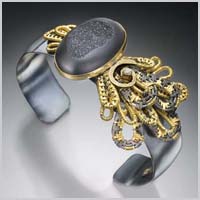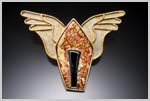
Information Center
Ralph Gabriner has over thirty years experience in photography and is please to share his knowledge with you in this section of his website.
| Topics: |
Juried Application Image Formats
In today's age, digital images are requested for most shows. There are currently two main formats for these images, both are .jpg files: ZAPP and JAS (Juried Art Services). The best description for these are on their sites. Click Here to go to the Links page for links to these sites.
Creating a Digital Image
The nasty surprises that my jeweler friends used to present me are no longer a problem. In the past, when shooting film, only one exposure could be made and if materials of different reflectivity were included in the piece that exposure had to be a compromise. Digital photography means that each material of a piece can be given its own exposure and a separate layer on a photoshop document. At the end of the post production process all of the layers can be merged into one seamless document.
What this means in plain English is that the best efforts of my good friend Sally Craig from SEC Designs came to naught when she tried to ruin my day by having me photograph a bracelet that included a diamond, a black druzy, high polish gold, and a gun metal finish. First, there is the gun metal finish, one of the most difficult patinas to capture well. Mostly it looks black. Place some light on it and it suddenly becomes shades of white and gray, including gleaming highlights. It is a very puzzling finish and the question of how best to preserve its character is a matter of some interpretation. Then there is the druzy. A large matte black stone with a high polish bezel in the center of the piece that absorbs light and causes any metal nearby to be blown out. On each flank of the bracelet is textured woven metal with a bright gold textured bar and a single diamond.
well. Mostly it looks black. Place some light on it and it suddenly becomes shades of white and gray, including gleaming highlights. It is a very puzzling finish and the question of how best to preserve its character is a matter of some interpretation. Then there is the druzy. A large matte black stone with a high polish bezel in the center of the piece that absorbs light and causes any metal nearby to be blown out. On each flank of the bracelet is textured woven metal with a bright gold textured bar and a single diamond.
In the days of film a piece like this could send a photographer to the mad house. With Photoshop®, however, I can make separate exposures for each problem area and then merge everything into one finished image. The assembly image graphics illustrate the point.
- The first photograph shows an overall exposure, the kind of look you might have gotten with film. It’s all right, but not special and elements of the piece merge too much with the background. This is probably the greatest sin committed by product photographers - never let the edge of a piece disappear into the background. The druzy and the gun metal are dangerously close to vanishing. Also, the textured metal in the shape of the number six is just a distant memory. There is no feeling in the metal and the diamond is gone.
- Figure #2 begins to correct this problem.
- Figure #3 shows the stone beginning to live a little. Highlights on matte black are an important way to give a piece life and so I place highlights on the front and rear of the piece.
- The left exterior of the band has no separation from the background in the preliminary shot, but Figure #6 takes care of that.
- Figure #7 - a separate exposure for the diamond is made.
- Figure #8 - all the layers are brought together in photoshop.
Voila, the piece jumps to life!
